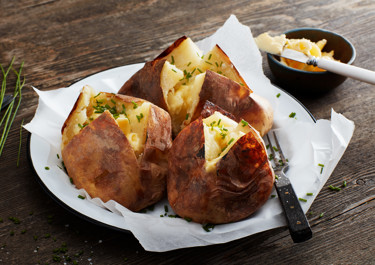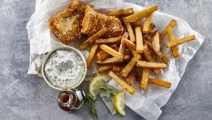&format=webp)
Jacket potato

Instructions
Step 1
Step 2
Step 3
Questions about jacked potatoes
Consensus is to never wrap your potatoes in foil and, while we tend to agree, it also depends on what you will be using it for. If a jacket potato with crispy skin is what you're after, foil is not the way to go as it will basically steam the vegetable, make the skins soggy, and result in a boiled potato taste. If you're making mash, however, this is the perfect consistency and, as an added bonus, the skins will be easy to remove.
While you may not have personally experienced an exploding potato, science tells us that it can easily happen. While cooking, the potato's water content will create steam and the spud will expand as a result. A few pricks to the skin will help the steam to safely escape, instead of being trapped and potentially causing a mini explosion that will be rather time consuming to clean.
Definitely. This adds both flavour and crispiness to the skins although, for the best results, some chefs recommend that you hold off on this step until the end of the cooking process. When there's 10 minutes left on the clock, remove the potatoes, brush them with oil and pop them back into the oven for the skins to reach the next-level of crispy, golden-brown perfection.
This draws out even more moisture during the baking process, resulting in the perfect potato that is crispy on the outside and beautifully fluffy on the inside.
Ingredients
|
Potatoes
|
2 |
|---|
The many uses and variations of the jacket potato
A longstanding staple of many a dinner menu, jacket potatoes are easy to make and loved by even the fussiest of eaters. While it is mostly served as a side dish, it can just as easily be transformed into the main attraction by adding protein such as pulled pork, a spicy chilli con carne or smoked salmon for a luxurious twist. Add a few extra toppings and sauces and you have dinner more than sorted.
This recipe is also great for gnocchi, a rustic salad, latkes (potato pancakes) or a creamy mash.
Side dishes to accompany jacket potatoes
Jacket potatoes, especially when fully loaded with toppings and sauces, is a heavy meal that is best accompanied by lighter side dishes. Our top picks are a fresh garden salad, blanched baby vegetables, or a juicy and sweet salad of watermelon and feta as a welcome contrast to the jacket potato's flavour and texture.
Serving ideas: sauces and classic toppings
From a simple dollop of sour cream or butter to a fully loaded spud with multiple toppings, the humble jacket potato lends itself to almost any flavour combination. Your sauce options can be as classic as a garlic, herb and sour cream combination, or more unusual like a strong-flavoured blue cheese sauce, a light and fresh tzatziki for a Mediterranean twist, or even a Mexican-inspired pico de gallo.
For toppings, a fun idea is to serve your jacket potatoes buffet style with a wide variety of options. Think anything from grated cheese, crispy bacon and fresh herbs to sauteed mushrooms, diced onion and taco meat. Add your sauces to the platter and you have a build-it-yourself dinner that will please any crowd.
A potato-inspired history lesson
A staple food across the globe and present in almost every culture, this humble tuber was domesticated about 8,000 years ago in the South American Andes. It only made its way to Europe in the mid-1500s and, from there, quickly became one of the world's most popular exports as it travelled to the west, the north, back to the Americas and far beyond. Years of cultivation in different soils and climates has led to more than 5,000 different types of potato that are enjoyed daily across the globe.










